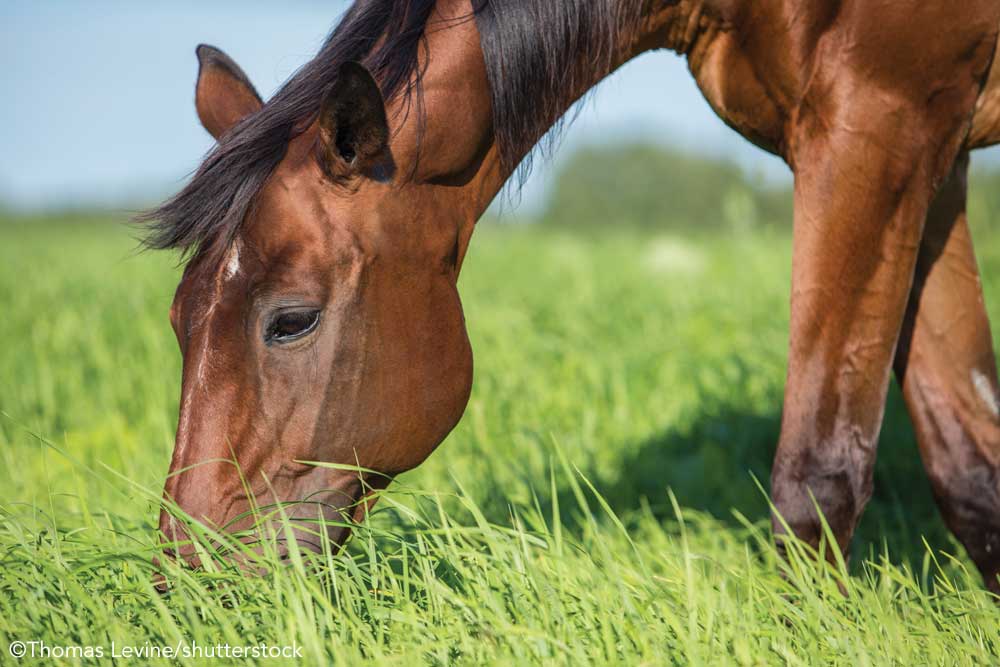Question: When was the last time you had a fecal egg count reduction test (FECRT) done on your horse?
If you answer, “Why on earth would my horse need that?” odds are your deworming plan needs updating.
However you answered, read on to learn what you’re doing right and what adjustments need to be made to keep your horse healthy and parasite-free with a deworming plan suited to your regional climate and individual horse.

The Link to Grazing
It might have been convenient in the “old days” to deworm every horse in the barn at the same time with the same product, but remember, that’s what got us in trouble with resistance. (See “Why Dewormer Rotation is Over” for the explanation.) So how do you know when your horse needs deworming—or if he doesn’t?
For owners whose horses have access to grazing, it may help to think of it this way: time on pasture = parasite exposure.
“The longer horses are on pasture, the more they are exposed to strongyle and tapeworm infection,” says Martin Nielsen, DVM, Ph.D., Dipl. ACVM, associate professor and equine parasitologist at the University of Kentucky Gluck Equine Research Center and co-author (with Craig Reinemeyer) of the Handbook of Equine Parasite Control.
“Climate has a huge effect on parasite transmission patterns, as it affects the duration of the grazing season and defines periods of high strongyle infection pressure,” he says. “In some areas, the grazing season may be just four to five months long, while other regions allow horses to be turned out on pasture year-round.”
Consider the grazing season in your region. All horses should be dewormed at the beginning and end of that season, or in other words, at least two times per year.
Some horses (the “high shedders,” who shed more strongyle eggs in their manure than the “low shedders”), will need additional deworming treatment during the grazing season, particularly in regions where that time period is lengthy or year-round.
“If [grazing season] is six months or less, the high shedders could get one additional treatment in the middle of the season, making it three treatments total,” says Nielsen. “In case the season is more like nine months long, perhaps add one more—but only for the high shedders.”
The Trouble with Fecal Egg Testing
Fecal testing is currently the most accurate way to detect the presence of adult strongyles and roundworms, two of the most common parasite species. However, fecal tests aren’t reliable when checking for tapeworms, bots or pinworms.
Tapeworms pass their eggs in tiny packets called proglotids. In dog and cat feces, these little bags full of tapeworm eggs look like grains of white rice. In horses, we don’t usually see intact proglotids because they tend to break up and the eggs disperse before the horse passes manure.
Researchers have proposed blood and saliva tests to check titers and determine if a horse is “positive” for tapeworms. Since such testing is not widely available for horse owners, general recommendations for treating a horse for tapeworms are based on his potential exposure, which includes region and exposure to pasture. Horses in a stall or dry lot have far less exposure than horses on pasture, but there is still some risk.
Generally speaking, the best time to treat for tapeworms is in the fall, although two treatments per year might be needed in some regions. This requires a dewormer containing praziquantel or pyrantel pamoate, as these active ingredients are effective against tapeworms. In arid climates or when horses have no access to grazing, tapeworms may not be a problem.
Bots are not detected in fecal tests either. Their yellow eggs are easily spotted after female bot flies lay them on the ends of the hair, typically on the horse’s front legs and shoulders. Egg presence is an indication to deworm your horse with a product containing an active ingredient (ivermectin, moxidectin) that’s effective against bots.
Pinworms won’t show up in a fecal test, but horses infected with them often show obvious signs of tail rubbing due to itching caused by these parasites. When treating, be aware that pinworms have shown resistance to ivermectin and moxidectin.
The Non-Grazing Horse and Parasite Control
The vast majority of parasites infect horses when they graze, so what about horses who have zero access to turnout on grass?
“Some clients insist on deworming because they’ve been told they have to, but once people understand parasite lifecycles, they realize it’s really hard for horses to get parasites in a place like Southern California,” says David Ramey, DVM, whose practice, Ramey Equine, has been based in the Los Angeles area since 1984.
“Horses here live in confinement situations where they never see any grass and their manure is removed once or twice daily, so it’s extraordinarily difficult for [pasture- borne] parasites to reproduce in this environment,” Ramey continues. “[Horses] poop onto desert sand where manure bakes in the sun and is picked up and removed anyway.”
When he sees a new horse or an existing client moves a horse in from another region, Ramey recommends a fecal test to get a baseline for parasite egg presence. “If the fecal test reveals parasites, we deworm,” he says. “From then on, we do fecal tests twice a year, and if they don’t have parasite eggs, we don’t deworm.
Because parasite resistance to deworming drugs is a real problem, Ramey encourages horse owners to use fecal tests, only deworm as needed, and to use management practices that reduce the chance of parasite infection, including daily manure removal.
“Climate has a huge impact,” says Nielsen. “In a state like California, some areas have very arid conditions and limited access to pasture. This means that pasture-borne parasites, such as strongyles and tapeworms, are less prominent, and in some areas they are no longer the main target parasites.”
Although horses without access to grass don’t have a “grazing season,” the American Association of Equine Practitioners (AAEP) guidelines recommend a baseline foundation of one, or possibly two, treatments per year be given to all horses. Your veterinarian can determine the best time for those treatments if your horse has no grazing season.
Nielsen explains that these recommendations are primarily to keep large strongyles from re-emerging as a problem.
“We have seen tremendous increases in the prevalence of Strongylus vulgaris in countries like Denmark and Sweden, where a large proportion of horses never or rarely get dewormed because of a tight administration of prescription-only restrictions,” says Nielsen.
He adds that another valid reason for baseline treatments are stomach worms, Habronema, which will not show up in fecal tests. Flies are responsible for the transmission of Habronema, so stomach worms can occur in arid places, like California, even in horses that aren’t on pasture. Flies deposit the larvae on wounds, as well as other moist areas, such as the horse’s lips, nostrils, et cetera. The larvae can create so-called summer sores: oozing, expanding infections that are tough to heal and tend to reappear.
Make Your Parasite Control Plan
“Bottom line, you have to adjust to the climate you’re in, how horses are kept there, and formulate a deworming plan based on that,” says Ramey.
The good news is, you’re not in this alone. Work with your veterinarian, use fecal testing to determine which dewormers work for your horse, deworm only when needed, and while you’re at it, keep your horse’s environment as manure-free as possible.
You’ll be doing your part to not increase parasite resistance and keeping your horse healthy at the same time.
Get familiar with the latest recommendations covered in “Internal Parasite Control Guidelines” from the American Association of Equine Practitioners, which can be found at www.aaep.org.
This article originally appeared in the April 2019 issue of Horse Illustrated magazine. Click here to subscribe!





